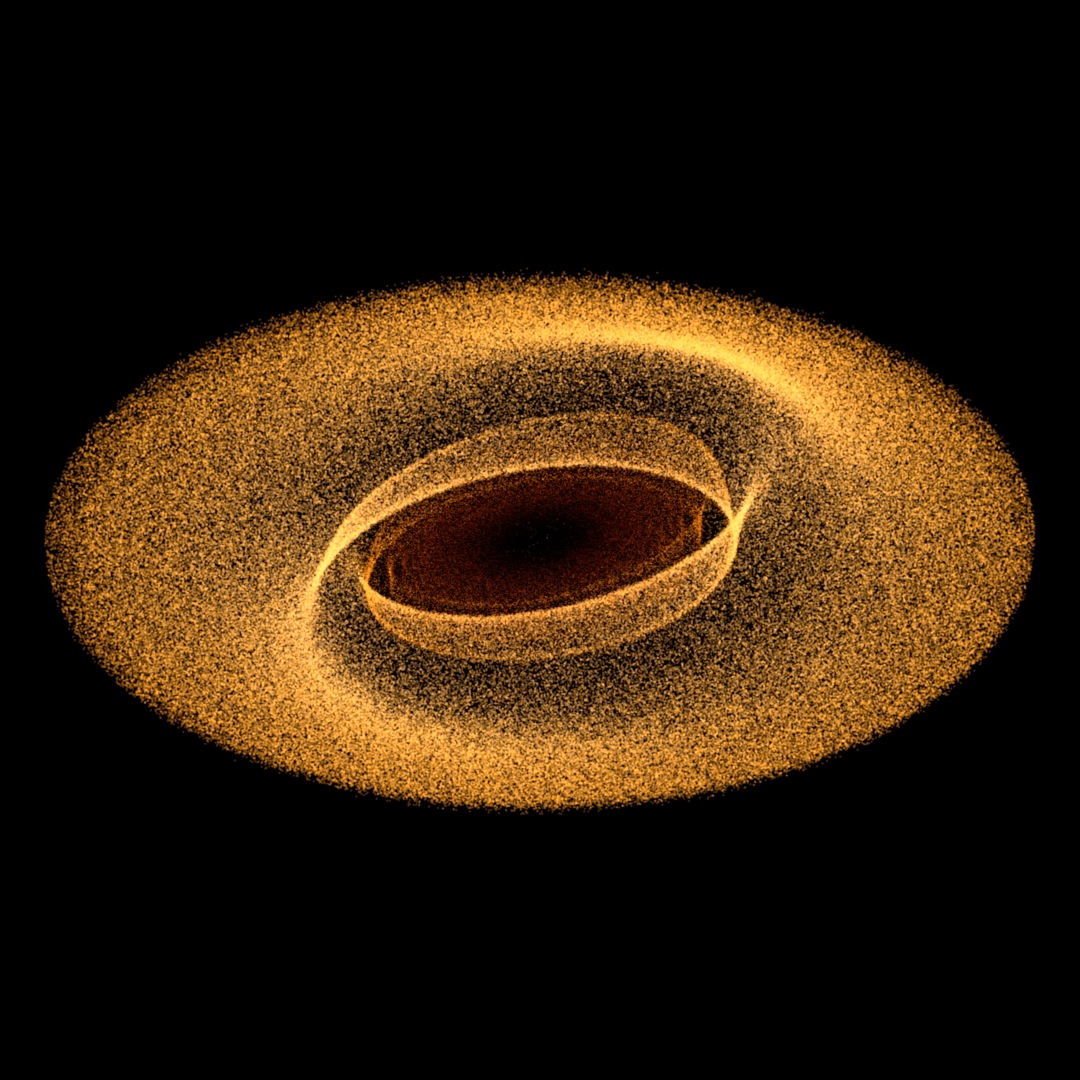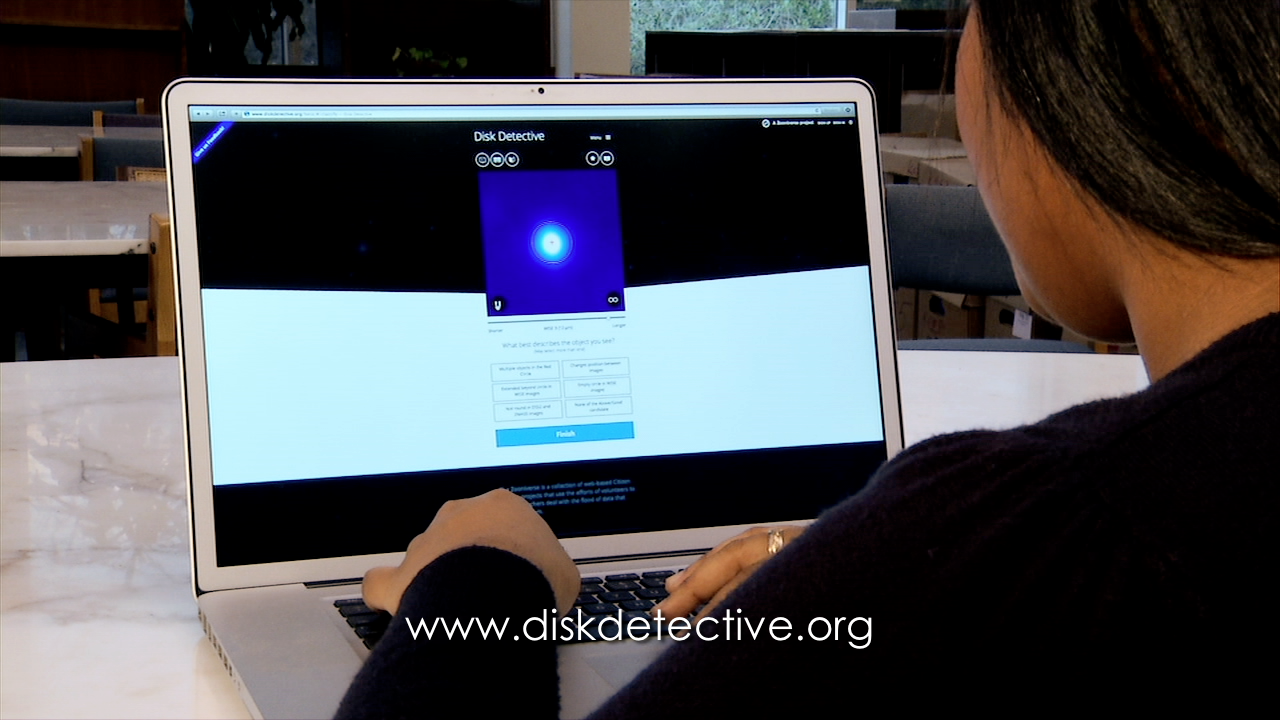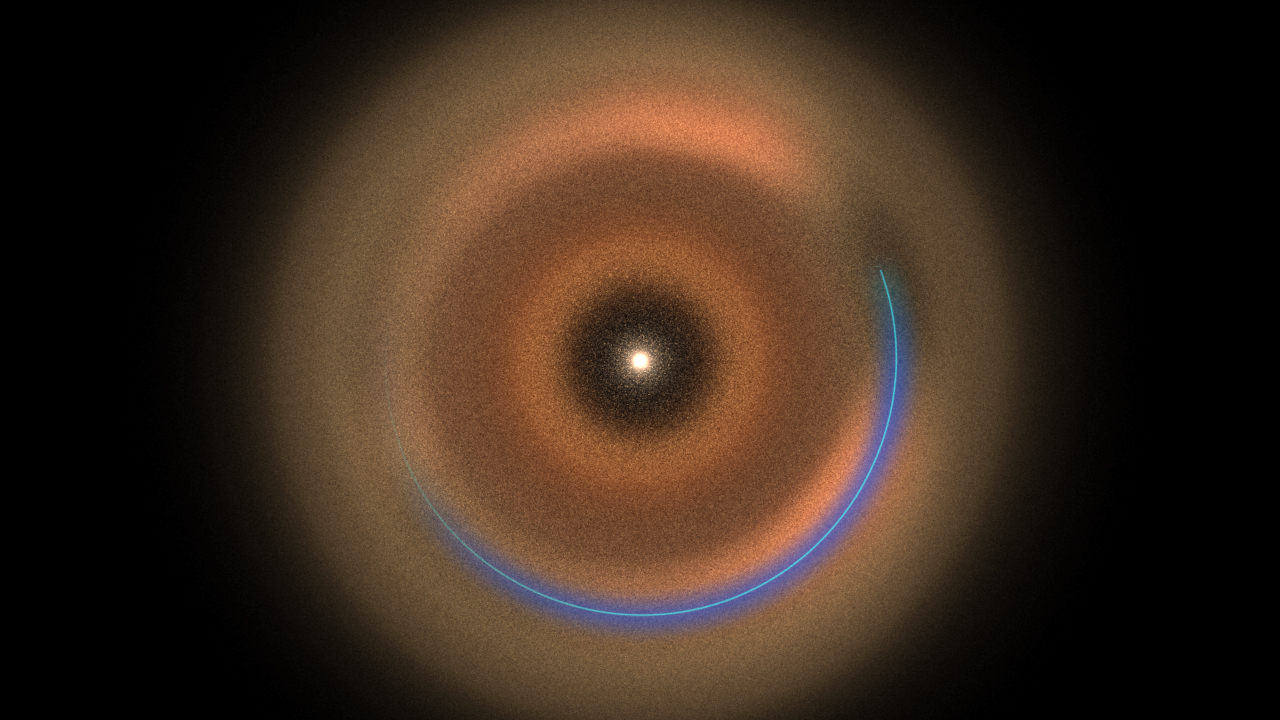Beta Pictoris: Icy Debris Suggests 'Shepherd' Planet
An international team of astronomers exploring the disk of gas and dust the bright star Beta Pictoris have uncovered a compact cloud of poisonous gas formed by ongoing rapid-fire collisions among a swarm of icy, comet-like bodies. The researchers suggest the comet swarm may be frozen debris trapped and concentrated by the gravity of an as-yet-unseen planet.
Using the Atacama Large Millimeter/submillimeter Array (ALMA) in Chile, astronomers mapped millimeter-wavelength light from dust and carbon monoxide (CO) molecules in a disk surrounding the star. Located about 63 light-years away and only 20 million years old, Beta Pictoris hosts one of the closest, brightest and youngest debris disks known, making it an ideal laboratory for studying the early development of planetary systems.
The ALMA images reveal a vast belt of carbon monoxide located at the fringes of the system. Much of the gas is concentrated in a single clump located about 8 billion miles (13 billion kilometers) from the star, or nearly three times the distance between the planet Neptune and the sun. The total amount of CO observed, the scientists say, exceeds 200 million billion tons, equivalent to about one-sixth the mass of Earth’s oceans.
The presence of all this gas is a clue that something interesting is going on because ultraviolet starlight breaks up CO molecules in about 100 years, much faster than the main cloud can complete a single orbit around the star. Scientists calculate that a large comet must be completely destroyed every five minutes to offset the destruction of CO molecules. Only an unusually massive and compact swarm of comets could support such an astonishingly high collision rate.
The researchers think these comet swarms formed when a as-yet-undetected planet migrated outward, sweeping icy bodies into resonant orbits. When the orbital periods of the comets matched the planet's in some simple ratio – say, two orbits for every three of the planet – the comets received a nudge from the planet at the same location each orbit. Like the regular push of a child's swing, these accelerations amplify over time and work to confine the comets in a small region.
Watch: NASA Goddard's Aki Roberge explains how observations with the Atacama Large Millimeter/submillimeter Array in Chile tell us about poison gas, comet swarms, and a hypothetical planet around Beta Pictoris.
Credit: NASA's Goddard Space Flight Center
Music: "Halos" by Lars Leonhard, courtesy of the artist and Ultimae Records.
Watch this video on the NASA Goddard YouTube channel.
For complete transcript, click here.

This artist's concept illustrates the preferred model for explaining ALMA observations of Beta Pictoris. At the outer fringes of the system, the gravitational influence of a hypothetical giant planet (bottom left) captures comets into a dense, massive swarm (right) where frequent collisions occur. The one planet known in the system, Beta Pictoris b, is shown near the star.
Credit: NASA's Goddard Space Flight Center/F. Reddy

The ALMA image of carbon monoxide around Beta Pictoris (above) can be deprojected (below) to simulate a view looking down on the system, revealing the large concentration of gas in its outer reaches. The middle panel shows orbits within the solar system to scale.
Credit: ALMA (ESO/NAOJ/NRAO) and NASA's Goddard Space Flight Center/F. Reddy

This ALMA image of carbon monoxide around Beta Pictoris shows the total emission from the J=3-2 rotational transition of the CO molecule, with a rest frequency of 345.796 gigahertz. The white region shows the location of the brightest emission. No labels.
Credit: ALMA (ESO/NAOJ/NRAO)/W. Dent et al.

The deprojected ALMA image of carbon monoxide around Beta Pictoris, simulating a view looking down on the system, revealing the large concentration of gas in its outer reaches. No labels.
Credit: Credit: ALMA (ESO/NAOJ/NRAO)/W. Dent et al.
This sequence compares the dust and gas in the Beta Pictoris disk. The contours show dust emission observed by ALMA and moving colors within the contours depict gas traveling at different velocities. It starts with gas in the upper left moving away from us and ends with gas in the lower right of the image that is moving toward us. This shift in velocity shows that the gas must be in orbit around the star.
Credit: ALMA (ESO/NAOJ/NRAO)/W. Dent
This animation models the dust produced by a planetary-scale impact involving a Mars-sized body, which is one possible explanation of the gas clump in the Beta Pictoris debris disk. The initial impact places a large amount of debris into orbit around the star, which mostly follows the orbit of the original body (blue circle). After a few thousand years, this has settled into an asymmetric disk with a bright spot at the location of the original impact (blue cross). Collisions between the debris are enhanced at the location of the bright spot, which persists for at least 100,000 years.
Credit: Univ. of Cambridge/A. Jackson
This sequence compares images of Beta Pictoris as seen by Hubble in visible light and ALMA. In the optical image, light from the bright star must be blocked by a disk (circle at center) because it completely saturates the detector in this region. Outside the occulting disk lies an edge-on belt of the finest dust grains, smaller than 1 micron across. ALMA observes at submillimeter wavelengths, where the star is relatively faint compared to the disk of gas and millimeter-sized dust grains. The location of the star is shown by the asterisk, and the position of the known Jupiter-mass planet is indicated by the cross. The CO gas disk appears slightly inclined to the main disk plane, and the bright clump appears to the right of the star. This gas disk is much larger than our solar system. The source of the Hubble image is here.
Credit: ALMA (ESO/NAOJ/NRAO)/W. Dent and NASA/ESA
For More Information
Credits
Please give credit for this item to:
NASA's Goddard Space Flight Center. However, individual images should be credited as indicated above.
-
Animator
- Scott Wiessinger (USRA)
-
Video editor
- Scott Wiessinger (USRA)
-
Narrator
- Aki Roberge (NASA/GSFC)
-
Producer
- Scott Wiessinger (USRA)
-
Scientist
- Aki Roberge (NASA/GSFC)
-
Project support
- Aaron E. Lepsch (ADNET Systems, Inc.)
-
Science writer
- Francis Reddy (University of Maryland College Park)
-
Writer
- Scott Wiessinger (USRA)
-
Illustrator
- Francis Reddy (University of Maryland College Park)
-
Graphics
- Francis Reddy (University of Maryland College Park)
Release date
This page was originally published on Thursday, March 6, 2014.
This page was last updated on Wednesday, May 3, 2023 at 1:51 PM EDT.
Series
This page can be found in the following series:Tapes
The media on this page originally appeared on the following tapes:-
Crashing Comets Hint at Hidden World
(ID: 2014021)
Thursday, March 6, 2014 at 5:00AM
Produced by - Robert Crippen (NASA)


